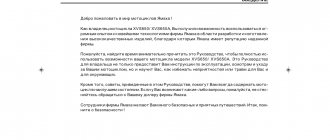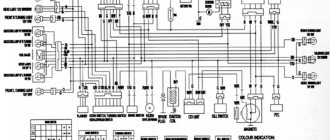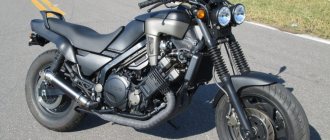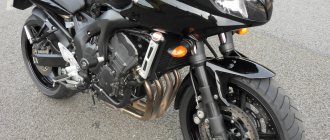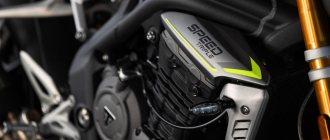Specifications
Technical characteristics of Yamaha FZ6 (N, S, R):
| Model | Yamaha FZ6 |
| Motorcycle type | naked |
| Year of issue | 2004-2009 (2017 – FZ6R / Diversion F) |
| Frame | aluminum diagonal steel diagonal – FZ6R / Diversion F |
| engine's type | 4-cylinder, 4-stroke, in-line |
| Working volume | 600 cm³ |
| Bore/Stroke | 65.5 x 44.5 mm |
| Compression ratio | 12,2:1 |
| Cooling | liquid |
| Number of valves per cylinder | DOHC, 4 valves per cylinder |
| Fuel supply system | injector, 4x 36 mm – FZ6-N, FZ6-S injector, 4x 32 mm – FZ6-R (XJ6 Diversion) |
| Ignition type | TCI |
| Maximum power | 98.0 hp (72.0 kW) at 12000 rpm – FZ6-N, FZ6-S 77.5 hp. (57.0 kW) at 10,000 rpm – FZ6-R, XJ6 Diversion |
| Maximum torque | 63.1 Nm at 10,000 rpm – FZ6-N, FZ6-S 59.7 Nm at 8,000 rpm – FZ6-R, XJ6 Diversion |
| Clutch | Multi-disc in oil bath, cable drive |
| Transmission | 6-speed |
| type of drive | chain |
| Front tire size | 120/70ZR 17M/C (58W) |
| Rear tire size | 180/55ZR 17M/C (73W) – FZ6-N, FZ6-S 160/60ZR 17M/C (69W) – FZ6-R (XJ6 Diversion) |
| Front brakes | 2 discs, 298 mm, 2-piston calipers – FZ6 (2004-2007), FZ6-R (XJ6 Diversion) 2 discs, 298 mm, 4-piston calipers – FZ6 (2008-2009), FZ6 S2 |
| Rear brakes | 1 disc, 245 mm, 2-piston caliper |
| Front suspension | 43 mm telescopic fork, 130 mm travel 41 mm telescopic fork, 130 mm travel – FZ6-R (XJ6 Diversion) |
| Rear suspension | Pendulum with monoshock absorber (adjustable preload), stroke – 130 mm |
| Overall dimensions (LxWxH) | 2095 x 755 x 1085 mm – FZ6-N 2095 x 750 x 1215 mm – FZ6-S 2120 x 770 x 1185 mm – FZ6-R (XJ6 Diversion) |
| Seat height | 795 mm – FZ6-N, FZ6-S 785 mm – FZ6-R (XJ6 Diversion) |
| Minimum ground clearance (clearance) | 145 mm – FZ6-N, FZ6-S 140 mm – FZ6-R (XJ6 Diversion) |
| Gas tank capacity | 19.4 l – FZ6-N, FZ6-S, FZ6 S2 17.3 l – FZ6-R (XJ6 Diversion) |
| Maximum speed | 219.3 km/h 207.0 km/h – FZ6-R (XJ6 Diversion) |
| Acceleration to 100 km/h | 3.8 sec 4.15 sec – FZ6-R (XJ6 Diversion) |
| Motorcycle weight (curb) | 201 kg / 206 kg – FZ6-N / FZ6-NA 207 kg / 212 kg – FZ6-S / FZ6-SA 205 kg / 211 kg – FZ6-R (XJ6 Diversion) / ABS |
Video
- Review and test drive of the Yamaha FZ1-N motorcycle.
- Review of the first generation of the Yamaha FZ1 Fazer (FZS1000) motorcycle.
Yamaha FZ-1
— the flagship model of the “Phaser” line, which traditionally includes motorcycles produced in several versions. Designed using the experience of producing the legendary YZF-R1 sportbike, the FZ-1 is, without exaggeration, a magnificent bike. In 2016, Yamaha presented a new MT-series model - the MT-10, which is destined to become its new flagship, displacing the Yamaha MT-09, but it is not yet entirely clear how the appearance of a new “liter” will affect the fate of the FZ-1. Considering the enormous popularity of this model, there is every chance that it will remain on the assembly line for a long time.
Externally, the older “Phaser” is very similar to its younger brothers - Yamaha FZ-6 and Yamaha FZ-8, and, like them, FZ-1 has two versions - FZ-1N, that is, a naked bike, and FZ-1S , that is, the version with a plastic fairing, also found under the name FZS 1000 (first generation only). The history of the model goes back two generations - the first was produced from 2001 to 2005, and the second was produced from 2006 to the present. The difference between generations is quite significant - more recent motorcycles received a diagonal aluminum frame instead of steel, an injector instead of carburetors, stronger brakes, improved suspension and a modified engine.
Speaking of the engine, it is perhaps one of the main advantages of the Yamaha FZ-1. This inline-four was borrowed from the YZF-R1, derated and retuned, ultimately producing 150 hp. (146 on the first generation FZ-1) and 106 Nm of torque. The engine of the flagship Phaser works best at medium speeds, reaching peak torque at 7500-8000 rpm, and peak power at 10000-11000 rpm. If we describe the dry numbers in simple words, then the FZ-1’s engine is simply crazy; it provides monstrous acceleration dynamics in its power.
It's no joke - one and a half hundred horsepower! Not all sportbikes of the same cubic capacity can boast of similar characteristics, and the Yamaha FZ-1 is not a sports bike, but a road bike. It picks up speed really, really quickly, and the solid engine size allows you to not change gears too often. The FZ-1 accelerates from 0 to 100 km/h in 3.6 seconds and has a top speed of 260 km/h. To be fair, it should be noted that on the S-version you can accelerate to such speeds if you lie down on the gas tank, but with the N-version the motorcyclist will begin to be blown away by the headwind much earlier.
The motorcycle has a fairly high center of gravity and considerable dry weight - 208 and 198 kg for the first and second generations, respectively, so it is not easy to move it on the spot, especially for short motorcyclists. The gas tank volume is not bad - 21 and 18 liters for the first/second generations. Considering the average declared consumption of less than 6 liters per hundred kilometers, this provides the bike with an excellent power reserve, so it is not surprising that some people travel far and with pleasure on the Yamaha FZ-1S. In addition, it is very comfortable to sit on this motorcycle - the seat is straight (although you can lean forward if you wish), all controls are located where logic dictates they should be, and the comfortable seat (driver's; passenger's seat, alas, does not have any advantages).
The suspensions are also quite good, and on the second generation Yamaha FZ-1 they have a set of adjustments, thanks to which you can customize their operation to suit your weight and your riding style. The brakes are also good and effective, especially on the second generation FZ-1, and an ABS version is also available. In general, Japanese designers have tried their best to provide the owner of this model with comfortable movement in any conditions. On the highway, the bike feels like a duck to water, overtaking and maneuvering with ease, and in the city, despite its width, it easily filters between cars thanks to its excellent maneuverability. Yes, its weight is felt only in static conditions, but on the move the FZ-1 is controlled with fabulous ease.
It is not surprising that this model has been so popular for a decade and a half. The Yamaha FZ-1 combines a lot of advantages - a monstrous engine, which also has good, especially for a “row” driver, low-end traction, a comfortable seating position, high reliability, tenacious brakes, good handling and excellent endurance. Perhaps this motorcycle can be called, without exaggeration, one of the best in its class.
Why adjust valves?
Many “riders”, when purchasing equipment, have little interest in its needs, which leads to rapid engine breakdown. The role of the valves is to supply the air-fuel mixture to the combustion chamber and remove exhaust gases. They operate under constant temperature conditions, and as you know, when heated, the metal begins to expand. Thermal expansion, together with gap deviation, leads to the fact that the valve may not close completely and the pusher is pinched, or vice versa, to too large a gap between the pusher and the valve.
If the intake valve has too large a gap between the pusher, then the combustion chamber is filled less with the mixture and the pusher breaks, and if the exhaust valve, the ventilation of the cylinder deteriorates. In both cases, this is felt as a loss of power and dynamic characteristics of the engine. When we talk about excessive clearance, then in this case the consumption may increase and a characteristic clattering sound can be heard.
That is, the engine requires adjustment of the gaps if:
- hard to start;
- does not start;
- stalls while driving;
- starts and stalls;
- consumption has increased;
- the maximum speed has decreased;
- a clattering sound is heard at the gas distribution mechanism;
- 500 km have passed since replacing the piston and cylinder group.
Brief history of the model
Model:
Yamaha FZ1 (FZS1000N/NC) USA.
Model:
Yamaha FZS1000 Fazer (Europe).
Model code:
5LV1, 5LV2, 5LV3, 5LV6.
Model:
Yamaha FZ1 (FZS1000P/PC) USA.
Model:
Yamaha FZS1000 Fazer (Europe).
Model code:
5LV8, 5LV9, 5LVA, 5LVD.
Model:
Yamaha FZ1 (FZS1000R/RC/SPR) USA.
Model:
Yamaha FZS1000 Fazer (Europe, South Africa).
Model code:
5LVF, 5LVH, 5LVN, 5LVP, 5LVR, 5LVG, 5LVM, 5LVU.
Model:
Yamaha FZ1 (FZS1S/SC) USA.
Model:
Yamaha FZS1000 Fazer / FZS10S (Europe, South Africa).
Model code:
1C21, 1C23, 1C27, 1C25, 1C26, 1C22, 5LVY.
Model:
Yamaha FZ1 (FZS1T/TC, FZ1T/TC) USA.
Model:
Yamaha FZS1000 Fazer / FZS1000S/T (Europe).
Model code:
1C2B, 1C29, 1C2A, 1C28, 1C2F.
Model:
Yamaha FZ1 (FZS10V/VC) USA.
Model:
Yamaha FZ1-N / FZ1-S Fazer (Europe, Australia).
Model code:
3C38, 3C37, 3C39, 3C32, 3C33, 3C31, 2D12, 2D13, 2D11, 3C36.
Model:
Yamaha FZ1 (FZS10W/WC) USA.
Model:
Yamaha FZ1-N / FZ1-S/SW Fazer (Europe, Australia).
Model code:
3C3C, 3C3B, 3C3A, 2D19, 2D18, 2D17, 2D16, 2D15, 2D14, 5D01, 5D02, 3C3F.
Model:
Yamaha FZ1 (FZS10XCR/XCGY) USA.
Model:
Yamaha FZ1-N / FZ1-S/SX Fazer (Europe, Australia, Japan).
Model code:
3C3K, 2D1G, 2D1D (Australia);
3C3J, 3C3H, 2D1F, 2D1E, 2D1C, 2D1B, 22C4, 22C3, 22C2, 22C1, 5D04, 5D03, 3C3N (Europe); 3C3G, 2D1A (Japan).
Model:
Yamaha FZ1 (FZS10YL/YCL, FZS10YG/YCG) USA.
Model:
Yamaha FZ1-N / FZ1-S/SY Fazer (Europe, Australia, Japan).
Model code:
3C3S, 2D1P, 2D1L (Australia); 3C3R, 3C3P, 2D1N, 2D1M, 2D1K, 2D1J, 22C8, 22C7, 22C6, 22C5, 5D05, 5D06, 3C3V (Europe); 3C3W (Japan).
Model:
Yamaha FZ1 (FZS10ZR/ZCR, FZS10ZB/ZCB) USA.
Model:
Yamaha FZ1-N/NA, FZ1-S/SA Fazer (Europe, Japan).
Model code:
1CA4, 5D09, 5D07, 3C3X, 1CA5, 22CB, 22C9, 1D1U, 2D1R (Europe); 1CA8, 2D1X (Japan).
Model:
Yamaha FZ1 (FZS10AS/ACS) USA.
Model:
Yamaha FZ1-N/NA, FZ1-S/SA Fazer (Europe, Japan).
Model code:
1CAE, 5D0D, 5D0B, 1CAF, 1CA9, 22CD, 1EC1 (Europe); 1CAJ (Japan).
Model:
Yamaha FZ1 (FZS10BW/BCW) USA.
Model:
Yamaha FZ1-N/NA, FZ1-S/SA Fazer (Europe, Japan).
Model code:
1CAS, 5D0F, 1CAK, 22CF, 1EC4 (Europe); 1CAU, 1CAT, 1EC8, 1EC7 (Japan).
Model:
Yamaha FZ1 (FZS10D/DC) USA.
Model:
Yamaha FZ1-S Fazer (Europe, Japan).
Model code:
1CAY (Europe); 2DV2 (Japan).
Model:
Yamaha FZ1 (FZS10EW/ECW, FZS10E/EC) USA.
Model:
Yamaha FZ1 (FZS10FGY/FCGY) USA.
Frame numbers of different generations of the Yamaha FZ-1 model:
| Year of issue | Frame number |
| 2001-2002 | RN06x |
| 2003-2004 | RN07x |
| 2005 | RN14x |
| 2006 | RN16x, FZ1 Fazer – RN17x |
| 2007 | RN17x |
| 2008- | RN21x |
Step by step process
Any rider can handle the valve adjustment process. This will take time, patience and desire. There is now such a variety of motorcycles offered that it is difficult to describe the procedure for each type. However, there are two main approaches - using adjusting washers or bolts (depending on what is used by the manufacturer).
In both cases you will need the following tools:
- keys (different, hex key is very convenient);
- feeler gauges (to measure the gap);
- micrometer (measuring instrument);
- magnet.
You can take a camera or smartphone to record the disassembly. Thanks to this, it will then be easier to correctly put the removed elements in their places. The adjustment is carried out when the engine has cooled and consists of several main stages:
- Familiarity with the instructions, finding out the required gap figure.
- Dismantling parts that prevent access to the engine. Usually the gas tank and seat are removed, various hoses and wires are disconnected. Everything is done carefully, remembering how to install it back. You can make notes with a marker or take photographs.
- Removing the plug located opposite the crankshaft. Thanks to the resulting hole, it will be possible to work with the crankshaft to find the dead spots at the top.
- Removing spark plugs and valve covers.
- Crankshaft rotation. Installing the piston at top dead centers. This is done one by one for all cylinders.
- Determining the size of the gaps using a feeler gauge. It fits between the rocker arm and the rod. Most often the distance should be 0.1 mm. You should take a probe of exactly this thickness and check whether it is maintained. If it moves but requires a little force, that's normal. If it doesn’t fit, it means the gap is small. If it passes freely, it’s big.
- Correction of clearances in valves where they do not meet the standard.
- Returning parts to their original place.
Review
What do we see here?
What catches your eye is the large fuel tank , which covers the aluminum frame of the motorcycle. Due to the fact that the engine sits quite tightly, there are no gaps. The front light has an interesting triangular shape with curves.
The Yamaha's speedometer is not located in the middle, but slightly to the side. Interestingly, when the engine is turned on, a self-test is first carried out , after which the engine starts, which is almost inaudible at idle.
Controllability
At high speed, it is quite easy to control the motorcycle, despite the weight of 180 kg, and the ride feels comfortable, thanks to the long-travel fork.
Bikers note easy maneuvering in traffic jams and stable cornering stability.
All controls respond to commands quickly, so you can safely concentrate on the road situation. Comparing this model with the R6, one feels that changing gears has become much easier, and a characteristic click is not heard when shifting. The riding process of the Yamaha FZ6-N has become a little better compared to the previous line of motorcycles.
Instrument cluster
The instrument cluster is completely electronic.
Digital instrument panel.
If at high speed the speed indicator is easy to read, then the tachometer clearly loses in this regard, since a narrow strip is allocated for it on the LCD display. By the way, this model received adaptive light , and now the low beam turns on automatically. The introduction of this technology was facilitated by changes in legislation.
Bleeding the hydraulic clutch
• Do not allow brake fluid to come into contact with the vehicle's paint surfaces. If this does happen, immediately clean up the spilled brake fluid.
Do not use a vacuum tool or any other type of special device to forcibly bleed the clutch hydraulic drive, as they will not ensure complete removal of air from the system.
1. Fill the reservoir with fresh brake fluid.
Do not reuse drained clutch hydraulic fluid.
2. Connect the transparent vinyl hose to the bleeder fitting (1).
RS5F92R
RS6F94R
3. Slowly depress and fully release the clutch pedal 15 times at intervals of 2-3 seconds, then release the clutch pedal.
HOT CAMS Adjusting washer 7.48 1.20
HOT CAMS Washer for adjusting thermal clearances of the gas distribution mechanism, diameter 7.48 mm, thickness 1.20 mm.
Used in engines of the following models:
AX-1 1988-1990 CB-1 1988-1990 CB1000R 2008-2014 CB1100 X11 CB1100A 2014 CB1100SA 2014 CB400SF Super Four 1992-2013 CB500F 2014 CB600F Hornet 1998-200 6 CB900F Hornet 2002-2007 CBR1000S 2014 CBR1000RR Fireblade 2004-2014 CBR1000S 2014 CBR1100XX Super Blackbird 1997-2003 CBR250R 2011-2013 CBR250R ABS 2011-2013 CBR600F2 Super Sport 1991-1994 CBR600F3 Super Sport 1995-1998 CBR600F4 1999-2000 CBR600F4i 2001-2006 CBR60 0RR 2003-2014 CBR600SJR 1996 CBR900RR Fireblade 1993-1999 CBR900RR (CBR929RR) Fireblade 2000-2001 CBR954RR Fireblade 2002-2003 CHF50 Metropolitan 2002-2009 CTX1300 AC2014 CTX1300A AC 2014 CRF150R 2007-2014 CRF250L 2013-2014 CRF250R 2005-2014 CRF250X 2 004-2013 FSC600 SilverWing 2002-2013 GL1800 Gold Wing 2001-2014 GL1800B 2014 GL1800C Gold Wing Valkyrie 2014 NPS50 Ruckus 2003-2014 NRX1800 Valkyrie Rune 2004-2005 NSS300 Forza 2014 NX250 1988-1990 ST1100 Pan European 1991-2002 ST1300 Pan European 2003-2012 ST1300PA Police Motorcycle 2012-2 014 VF750C Magna 1995-2003 VFR1200F 2010-2013 VFR1200F DCT 2010 -2013 VFR750F 1990-1997 VFR800 Interceptor 1998-2009
Bajaj-Club
As you know from the service manual, valve adjustment is done by selecting washers according to thickness. True, even at first glance, this procedure hides a very big problem. The washers come with a pitch of 0.04 mm, and the nominal clearance at the inlet is 0.05 mm, at the outlet 0.10 mm. That is, at the inlet, adjusting the gap with a washer in increments equal to the gap is impossible. Because if 0.05 mm is the minimum gap, then it can only be set with an accuracy of almost + infinity (from 0.05 to 0.08 mm, the result is a 60% miss).
But that's okay. The main question is: do dealers have washers? Or I’ll even pose the question even more cunningly - did anyone have the clearances adjusted during maintenance? If yes, please respond.
Re: Valve adjustment
- Quote
Post by Paluch » Jul 26, 2022, 04:21 pm
Re: Valve adjustment
- Quote
Post by Dmitro » Jul 26, 2022, 4:35 pm
Re: Valve adjustment
- Quote
Post by alex.engine » 26 Jul 2022, 20:06
According to the manual, it is completely accessible, and not only to dealers. There's nothing super secret there.
But I gave unverified information - I was wrong. It turns out that the pitch changes - somewhere it is 0.04 mm, but mostly 0.02 mm. And the gaps are 0.05 mm inlet and 0.08 mm exhaust.
But it doesn't matter how many there are. Since I don’t really believe that dealers have the entire set of washers, I doubt a little that anyone actually had the adjustment done. That's why I ask.
Adjusting the valves of YAMAHA TW200.
Remove the seat and two plastic sides. Disconnect the fuel hose from the gas tank while closing the fuel valve.
Edited by Kuler (2010-10-29 11:24:08)
Share22010-10-29 10:46:13
- Author: Kuler
- old man
- From: MO
- Registered: 2010-10-26
- Invitations: 0
- Posts: 604
- Respect: [+28/-0]
- Positive: [+28/-0]
- Time spent on the forum: 4 days 22 hours
- Last visit: 2020-05-14 11:19:23
Using a large flat screwdriver, unscrew the two plastic plugs on the left crankcase cover.
Share32010-10-29 10:47:15
- Author: Kuler
- old man
- From: MO
- Registered: 2010-10-26
- Invitations: 0
- Posts: 604
- Respect: [+28/-0]
- Positive: [+28/-0]
- Time spent on the forum: 4 days 22 hours
- Last visit: 2020-05-14 11:19:23
Using a socket wrench, unscrew the two valve adjustment window covers.
Edited by Kuler (2010-10-29 11:13:21)
Share42010-10-29 10:48:43
- Author: Kuler
- old man
- From: MO
- Registered: 2010-10-26
- Invitations: 0
- Posts: 604
- Respect: [+28/-0]
- Positive: [+28/-0]
- Time spent on the forum: 4 days 22 hours
- Last visit: 2020-05-14 11:19:23
Using a 17mm wrench, turn the crankshaft counterclockwise, while looking through the top window to align the “T” mark.
NOTE: To make cranking easier, remove the spark plug in advance.
ATTENTION: since the engine is 4-stroke, aligning the mark in the window is not sufficient. It is necessary to control the valve pushers while the crankshaft is rotating, i.e. when the marks are aligned, at one moment the valves can be clamped, and when the marks are subsequently aligned (next revolution), the valves are free. In this case, it is better to control it with a thin strip of a feeler gauge inserted between the pusher and the valve. That is, when, when aligning the mark, the dipstick does not fit between the pusher and the valve, we turn the crankshaft one more revolution until the mark is aligned, then the dipstick will pass. This can also be controlled visually: when the valve tappets rise, you can begin to adjust.
How to adjust the valves on a walk-behind tractor - we outline in detail
How the adjustment is made
walk-behind
tractor
?
The walk-behind tractor has long been known as a means of plowing land. For normal operation of the device, adjustment of the walk-behind tractor valves is necessary, which should be done at least once a year. This unit greatly simplifies human work. With various attachments, it can do all agricultural work. It is also used for vehicles for cargo transportation. Well, he will deliver himself to significant distances on his own.
Brief history of the model
- 2004 - The official start of production and sales of the Yamaha FZ6N and Yamaha FZ6S, which replaced the Yamaha FZS 600 model.
- 2006 - The model receives updates to the engine and fuel injection system to obtain better low-end torque and a smoother power take-off. Additionally, the bike gets a new frame, swingarm and wheels in black.
- 2007 - The European version of the Yamaha FZ6 was "strangled" to 78 hp, however, a full-power (98 hp) version of the Yamaha FZ6 S2 was also available, which had a slightly different seat, passenger pegs, brake calipers and dashboard from Yamaha FZ1.
- 2008 – The European version of the Yamaha FZ6 S2 now comes with ABS and an immobilizer as standard on the motorcycle.
- 2009 - only versions of the Yamaha FZ6 S2 are sold on the European market.
- 2010 - in the US market, the Yamaha FZ6 series is completely replaced by the Yamaha FZ6R (with a full fairing); in Europe, the Yamaha FZ6 Fazer S2 (with a semi-fairing) and the Yamaha FZ6 S2 (naked version) continue to be sold. The derated (78 hp) versions of the motorcycle were replaced by the Yamaha XJ6 Diversion model series. In the same year, the FZ6 was replaced by the updated Yamaha FZ8 model.
Brief history of the model
Model:
Yamaha FZ6 (Naked), Yamaha FZ6 Fazer (all regions).
Model code:
5VX3, 5VX4 (North America), 1B31, 5VX1, 5VX5 (Europe), 5VX2 (Oceania).
Model:
Yamaha FZ6 (Naked) / FZ6-N, Yamaha FZ6 Fazer / FZ6-S (all regions).
Model code:
5VX8, 5VX9 (North America), 1B33, 1B35, 5VX6 (Europe), 1B34, 1B36, 5VX7 (Oceania).
Model:
Yamaha FZ6 (Naked) / FZ6-N + ABS, Yamaha FZ6 Fazer / FZ6-S + ABS, Yamaha FZ6-S2 / S2 Fazer (all regions).
Model code:
5VXH, 5VXJ (North America), 1B3B, 1B37, 1B39, 5VXB, 5VXD, 4P51, 4P52, 5VXK (Europe), 1B3A, 1B3C, 1B38, 5VXC, 5VXG (Oceania).
Model:
Yamaha FZ6 (Naked) / FZ6-N + ABS, Yamaha FZ6 Fazer / FZ6-S + ABS, Yamaha FZ6-S2 / S2 Fazer + ABS (all regions).
Model code:
4S82, 4S83 (North America), 1B3D, 5VXL, 5S51, 5S41, 5S31, 5S21, 4S81 4S84,, 4P54, 4P53 (Europe), 5S52 (Oceania).
Model:
Yamaha FZ6 (Naked) / FZ6-N + ABS, Yamaha FZ6 Fazer / FZ6-S + ABS, Yamaha FZ6-S2 / S2 Fazer + ABS (all regions).
Model code:
4S88, 4S89 (North America), 5S53, 5S42, 5S22, 4S86, 4S8A (Europe), 5S54, 4S87 (Oceania).
Model:
Yamaha FZ6 (Naked) / FZ6-N + ABS, Yamaha FZ6 Fazer / FZ6-S + ABS, Yamaha FZ6-S2 / S2 Fazer + ABS, Yamaha FZ6-R (all regions).
Model code:
5S56, 4S8C (Oceania), 5S55, 5S44, 5S43, 5S57, 5S23, 4S8B, 36P6, 36P3, 4S8F (Europe).
Model:
Yamaha FZ6R (North America).
Model code:
FZ6RZW, FZ6RZL, FZ6RZR, FZ6RZCW, FZ6RZCR, FZ6RZCL, FZ6RZCB, FZ6RZB.
Why is it worth buying spare parts in the online store Zapchasti.lviv.ua?
- We have motorcycle spare parts for YAMAHA for the most popular brands of cars, we will also select other running spare parts;
- We help with the selection of original spare parts and full-fledged analogues;
- we assume all risks and all communications with the Polish side;
- Our prices for motorcycle spare parts for YAMAHA are better than those of our competitors;
- We deliver in 5-7 days to any point in Ukraine;
- It is possible to return the spare part if no more than 14 days have passed from the date of placing the order.
Buying motorcycle spare parts for YAMAHA is easy, place an order in the online store or call us 0800 337 571 (Calls within Ukraine are free).
